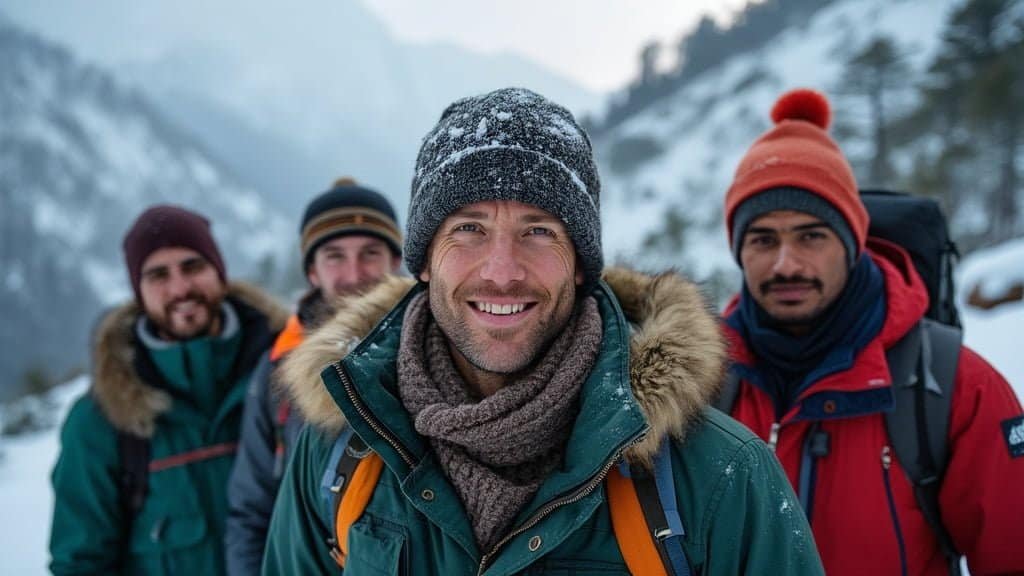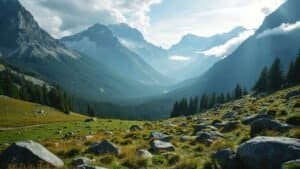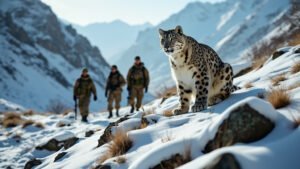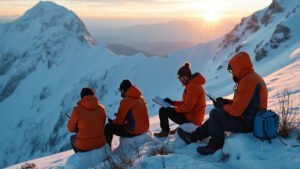Introduction
Snow leopards, known for their elusive nature and majestic beauty, are facing increasing threats from habitat loss, poaching, and climate change. The role of local communities in conserving these endangered big cats is pivotal
This article explores various ways in which local communities contribute to snow leopard conservation, including actions taken on the ground, sustainable practices, cultural influences, and involvement in ecotourism
Additionally, it delves into the partnerships and challenges faced by these communities, highlighting both successes and areas for future growth
Actions Taken by Local Communities
Snow leopards, native to the mountainous regions of Central and South Asia, rely heavily on the efforts of local communities for their conservation. These communities, living in close proximity to snow leopard habitats, are uniquely positioned to implement and sustain effective conservation practices
This section explores the specific actions taken by these communities, highlighting their critical role in preserving snow leopard populations
Wildlife Monitoring and Research
Local communities play a crucial role in wildlife monitoring and research efforts aimed at conserving snow leopards
Community members are often trained to use camera traps, GPS tracking, and other technologies to monitor snow leopard movements and behaviors. This data is invaluable for understanding the ecology of these elusive cats and identifying critical habitats that need protection
For instance, in the Spiti Valley of India, local villagers have been instrumental in setting up and maintaining camera traps. Their efforts have provided scientists with essential data on snow leopard populations and their prey, enabling more effective conservation strategies
Similarly, in Mongolia, local herders collaborate with researchers to track snow leopards using GPS collars. These community-driven initiatives not only enhance scientific knowledge but also foster a sense of ownership and responsibility among locals
Community Education and Awareness
Education is a powerful tool in conservation, and local communities often spearhead educational initiatives to raise awareness about the importance of protecting snow leopards
These programs typically include workshops, school curricula, and community meetings designed to inform and engage people of all ages
In Nepal, the Snow Leopard Conservancy has partnered with local schools to incorporate conservation education into their curricula. Children learn about the ecological significance of snow leopards and the threats they face, fostering a conservation ethic from a young age
Additionally, community-based organizations in Kyrgyzstan conduct regular workshops to educate adults about the benefits of snow leopard conservation, such as increased tourism revenue and ecosystem health
Anti-Poaching Initiatives
Local communities are often on the front lines of anti-poaching efforts, working to protect snow leopards from illegal hunting and trade
Community members serve as wildlife rangers, patrolling protected areas and reporting any signs of poaching activity. These initiatives are often supported by conservation organizations that provide training, equipment, and financial incentives
In Pakistan’s Gilgit-Baltistan region, community-led anti-poaching teams, known as Village Wildlife Guards, have significantly reduced poaching incidents
These guards are equipped with training in wildlife law enforcement and basic fieldcraft, allowing them to effectively monitor and protect snow leopard habitats. Similar programs in Tajikistan and Bhutan have also seen success, with local rangers playing a pivotal role in curbing illegal hunting and trade
Community-Driven Conservation Programs
Beyond monitoring, education, and anti-poaching efforts, local communities engage in comprehensive conservation programs that integrate various activities to protect snow leopards. These programs often include habitat restoration projects, conflict mitigation strategies, and sustainable livelihood initiatives
In the Indian state of Himachal Pradesh, the community-based Snow Leopard Conservation Project involves multiple activities, from restoring degraded habitats to implementing livestock insurance schemes
These efforts help reduce human-wildlife conflict and provide economic benefits to local people, making conservation a viable and attractive option. Similarly, in China, the Shan Shui Conservation Center works with local communities to develop and implement conservation plans tailored to the unique needs and challenges of each area
Empowerment and Ownership
One of the most significant outcomes of community involvement in snow leopard conservation is the empowerment and sense of ownership it fosters
When local people are actively engaged in protecting their natural heritage, they are more likely to support and sustain conservation efforts over the long term. This empowerment is often reflected in the leadership roles that community members take on within conservation projects, further strengthening the resilience and effectiveness of these initiatives
For example, in the Annapurna Conservation Area of Nepal, community members not only participate in conservation activities but also lead them, making decisions about resource allocation, project implementation, and conflict resolution
This model of community-led conservation has proven highly effective in ensuring the long-term survival of snow leopards in the region
Sustainable Practices Supporting Snow Leopard Habitats
Sustainable practices are essential in maintaining the health of ecosystems that support snow leopards. Local communities, whose livelihoods often depend on these ecosystems, have developed and implemented various sustainable practices that benefit both the environment and their socio-economic well-being
This section delves into how sustainable agriculture, livestock management, and habitat restoration contribute to snow leopard conservation
Sustainable Agriculture
Agriculture, when practiced sustainably, can significantly enhance the conservation of snow leopard habitats. Local communities adopt various sustainable agricultural practices to reduce their ecological footprint and ensure that the surrounding environment remains conducive to wildlife
In many snow leopard habitats, traditional farming techniques are being replaced or supplemented with sustainable methods. For instance, in the Himalayas, terraced farming and organic agriculture are promoted to prevent soil erosion and reduce chemical runoff into local waterways
These practices not only improve crop yields and soil health but also maintain the integrity of the landscape, which is crucial for snow leopards and their prey
Additionally, agroforestry, the integration of trees and shrubs into agricultural lands, is gaining popularity. This practice helps in carbon sequestration, soil stabilization, and biodiversity enhancement. By creating a more diverse and stable ecosystem, agroforestry supports the prey species that snow leopards rely on, thereby indirectly benefiting the big cats themselves
Livestock Management
Livestock rearing is a major livelihood for many communities living in snow leopard habitats. However, it can lead to conflicts with snow leopards when predators attack livestock. To address this, communities have adopted sustainable livestock management practices that reduce conflicts and promote coexistence
One effective strategy is the use of predator-proof corrals, which are enclosures designed to protect livestock from snow leopard attacks. In Mongolia, herders have been supported by the Snow Leopard Trust to build such corrals, resulting in a significant decrease in livestock losses and retaliatory killings of snow leopards
Another approach is the implementation of livestock insurance schemes, which compensate herders for losses caused by predators. This reduces the financial burden on herders and fosters a more tolerant attitude towards snow leopards
Rotational grazing is another sustainable practice that benefits both livestock and wildlife. By rotating grazing areas, communities can prevent overgrazing, which degrades habitats and reduces the availability of prey for snow leopards. This practice also allows vegetation to recover, maintaining a healthy ecosystem that supports a diverse range of species
Habitat Restoration
Habitat restoration is a critical component of snow leopard conservation. Local communities actively participate in restoring degraded habitats to ensure that these areas remain viable for snow leopards and other wildlife
In areas where overgrazing and deforestation have led to habitat degradation, reforestation projects are implemented. Communities plant native tree species to restore forest cover, which in turn helps in soil stabilization, water regulation, and climate mitigation
For example, in the Central Asian mountains, local communities engage in planting initiatives to restore alpine meadows and forest areas, creating suitable habitats for snow leopards and their prey
Furthermore, wetland restoration projects are carried out to revive water sources and improve the overall health of the ecosystem
In Kyrgyzstan, community-led efforts have successfully restored several wetlands, which provide crucial water resources for both wildlife and human populations. These restored wetlands support a rich biodiversity, including prey species that are vital for snow leopards
Sustainable Tourism
Sustainable tourism, particularly ecotourism, is another avenue through which local communities support snow leopard habitats. By promoting responsible tourism practices, communities can generate income while minimizing negative impacts on the environment
Ecotourism initiatives often include guidelines for tourists to follow, such as staying on designated trails, minimizing waste, and respecting wildlife. These guidelines help protect fragile habitats from degradation
In Ladakh, India, community-run homestays and eco-lodges provide an authentic experience for tourists while promoting conservation. Tourists are educated about the importance of snow leopard conservation and the role they can play in protecting these majestic animals
Revenue generated from ecotourism is often reinvested into conservation projects. This creates a positive feedback loop where tourism supports conservation, and healthy ecosystems attract more tourists. In Bhutan, for example, the revenue from ecotourism has funded numerous conservation initiatives, including habitat restoration, wildlife monitoring, and community education programs
Cultural Practices and Snow Leopard Conservation
Cultural practices play a significant role in the conservation of snow leopards. Local traditions, beliefs, and customs often shape community attitudes and behaviors towards wildlife, influencing conservation efforts in profound ways
This section explores how traditional beliefs, community celebrations, and local leadership contribute to snow leopard conservation
Traditional Beliefs and Practices
Many local communities have traditional beliefs and practices that inherently support wildlife conservation. These cultural norms often dictate respectful and sustainable interactions with nature, including the protection of snow leopards
In several regions of the Himalayas, snow leopards are revered as sacred animals, often associated with local deities or spiritual beliefs. In Bhutan, for example, snow leopards are considered the guardians of the mountains and are protected by Buddhist principles
The concept of “Lhapka,” a traditional belief that certain areas are sacred and should not be disturbed, helps preserve critical habitats for snow leopards
Additionally, in Mongolia, the spiritual belief in the “spirit of the mountains” ensures that herders do not harm snow leopards, viewing them as a vital part of their natural heritage. These cultural values are passed down through generations, fostering a deep-seated respect for snow leopards and promoting their conservation
Community Celebrations and Festivals
Community celebrations and festivals play a pivotal role in raising awareness about snow leopard conservation. These events provide a platform for education, engagement, and the reinforcement of cultural values that support wildlife protection
The annual Snow Leopard Day in Kyrgyzstan is a prime example of how festivals can promote conservation. This event brings together communities, conservationists, and government officials to celebrate the importance of snow leopards
Activities include educational programs, cultural performances, and awards for individuals and groups who have made significant contributions to conservation efforts. Such events help to strengthen community ties and foster a collective commitment to protecting snow leopards
Similarly, in Nepal, the Hemis Festival, held in the Hemis Monastery in Ladakh, features traditional dances and rituals that highlight the cultural significance of snow leopards. These festivals attract both locals and tourists, creating opportunities for conservation education and the promotion of sustainable tourism practices
Local Leadership and Governance
Effective local leadership and governance are crucial for the success of community-led conservation initiatives. Local leaders often play a key role in mobilizing community members, securing resources, and ensuring the implementation of conservation activities
In Pakistan’s Gilgit-Baltistan region, the Snow Leopard Foundation collaborates with local leaders to develop and implement conservation plans
These leaders, respected within their communities, help to garner support for conservation initiatives and ensure compliance with conservation guidelines. Their involvement is instrumental in bridging the gap between traditional practices and modern conservation techniques
Community-based organizations also play a significant role in local governance. In Tajikistan, the “Tajikistan Snow Leopard Program” empowers local communities to form conservation committees that oversee the protection of snow leopards
These committees are responsible for monitoring wildlife, managing human-wildlife conflicts, and promoting sustainable practices. By involving local communities in decision-making processes, these initiatives foster a sense of ownership and accountability
Integration of Cultural Practices into Conservation Strategies
Integrating cultural practices into formal conservation strategies can enhance the effectiveness and sustainability of conservation efforts
Recognizing and respecting local traditions while introducing modern conservation techniques can create a harmonious and effective approach to wildlife protection
For instance, the Snow Leopard Trust’s community-based conservation model incorporates traditional herding practices with modern techniques to reduce human-wildlife conflict. By providing herders with predator-proof corrals and livestock insurance, while respecting their traditional ways of life, the program has successfully reduced retaliatory killings of snow leopards
Similarly, the “Sacred Himalayan Landscape” initiative in Nepal integrates traditional land-use practices with biodiversity conservation. By recognizing sacred groves and culturally significant landscapes, this initiative ensures the protection of critical habitats while respecting local cultural values
Promoting Cultural Tourism
Cultural tourism offers an opportunity to showcase traditional practices and promote conservation simultaneously. By attracting tourists to experience local cultures and learn about snow leopard conservation, communities can generate income and raise awareness
In Ladakh, India, cultural tours that include visits to monasteries, traditional villages, and wildlife sanctuaries provide a unique experience for tourists
These tours often include educational components about snow leopards and conservation efforts, fostering a deeper understanding and appreciation among visitors. The revenue generated from cultural tourism supports local conservation initiatives, creating a sustainable model for both cultural preservation and wildlife protection
Community Involvement in Ecotourism
Ecotourism has emerged as a powerful tool for snow leopard conservation, offering economic benefits to local communities while promoting sustainable environmental practices
When managed effectively, ecotourism can enhance conservation efforts by providing alternative livelihoods, raising awareness, and generating funds for conservation projects. This section examines the benefits, challenges, and successful case studies of community involvement in ecotourism
Benefits of Ecotourism
Ecotourism provides numerous benefits to local communities and the environment, making it a viable strategy for snow leopard conservation. One of the primary benefits is the generation of income for communities living in snow leopard habitats
By offering guided tours, homestays, and cultural experiences, locals can earn a sustainable livelihood that reduces their dependence on activities that may harm the environment, such as poaching or overgrazing
In Ladakh, India, community-based ecotourism initiatives have provided significant economic benefits. Local families host tourists in their homes, offering a unique cultural experience while educating visitors about snow leopard conservation. The income generated from these activities helps improve the standard of living for local families and supports community development projects, such as building schools and healthcare facilities
Another benefit of ecotourism is the increased awareness and appreciation for wildlife conservation
Tourists who visit snow leopard habitats often leave with a deeper understanding of the challenges facing these big cats and the importance of preserving their ecosystems. This heightened awareness can lead to increased support for conservation initiatives, both financially and through advocacy
Challenges of Ecotourism
Despite its benefits, ecotourism also presents several challenges that need to be managed to ensure its sustainability and effectiveness in conservation
One major challenge is the potential for environmental degradation due to increased human activity. Without proper management, tourist influx can lead to habitat destruction, pollution, and disturbance to wildlife
To address these challenges, strict guidelines and regulations must be implemented. For example, limiting the number of visitors, ensuring waste management practices, and promoting eco-friendly accommodations are essential measures to minimize the ecological footprint of tourism
In Bhutan, the government has adopted a high-value, low-impact tourism policy to control the number of tourists and maintain the integrity of its natural and cultural heritage
Another challenge is ensuring that the benefits of ecotourism are equitably distributed among community members. In some cases, only a few individuals or groups may profit from tourism, leading to disparities and potential conflicts within the community. Transparent management and inclusive participation in decision-making processes are crucial to address this issue
Case Studies of Successful Ecotourism Projects
Several successful ecotourism projects around the world demonstrate how community involvement can lead to positive conservation outcomes for snow leopards. These case studies highlight the innovative approaches and best practices that can be replicated in other regions
In Mongolia, the Snow Leopard Conservation Foundation has developed a community-based ecotourism program that involves local herders as guides
Tourists participate in wildlife tracking, horseback riding, and cultural exchanges, learning about the traditional nomadic lifestyle and snow leopard conservation efforts. The program has generated significant income for local communities, reduced poaching, and fostered a sense of pride and ownership in conservation
Another successful example is the “Himalayan Homestays” program in India. This initiative, supported by the Snow Leopard Conservancy India Trust, provides training and support to local families to host tourists in their homes
The program has improved the economic well-being of participating families, reduced human-wildlife conflict by promoting tolerance towards snow leopards, and enhanced the conservation of snow leopard habitats through community engagement and education
In Kyrgyzstan, the “Kyrgyz Ecotourism Initiative” offers guided treks and cultural tours in the Tien Shan mountains, home to a significant population of snow leopards
Local guides, trained in wildlife conservation and eco-friendly practices, lead these tours, providing an immersive experience for tourists while promoting conservation awareness. The initiative has successfully balanced tourism development with environmental conservation, benefiting both local communities and snow leopards
Promoting Sustainable Ecotourism Practices
To maximize the benefits and minimize the challenges of ecotourism, promoting sustainable practices is essential. This involves educating both tourists and local communities about the principles of responsible tourism and the importance of conservation
Tour operators and guides play a crucial role in promoting sustainable practices. They can educate tourists about the fragility of snow leopard habitats, the importance of minimizing their impact, and how they can contribute to conservation efforts. Providing training to local guides on wildlife conservation, sustainable tourism, and hospitality ensures that they can deliver high-quality and responsible tourism experiences
Community involvement in the planning and management of ecotourism projects is also vital
By involving locals in decision-making processes, their knowledge and insights can help develop tourism practices that are culturally appropriate and environmentally sustainable. This inclusive approach fosters a sense of ownership and ensures that the benefits of ecotourism are shared equitably
Partnerships and Collaborations
Partnerships and collaborations between local communities, conservation organizations, government agencies, and international bodies are essential for the effective conservation of snow leopards. These collaborations leverage diverse resources, expertise, and support systems to enhance conservation efforts
This section explores how these partnerships contribute to snow leopard conservation
Conservation Organizations
Conservation organizations play a crucial role in supporting local communities in their efforts to protect snow leopards. These organizations provide funding, technical expertise, training, and other resources needed to implement effective conservation programs
The Snow Leopard Trust, for instance, works closely with communities across snow leopard habitats, offering programs that combine scientific research with community-based conservation
They provide training in wildlife monitoring, support the development of predator-proof corrals, and implement livelihood programs to reduce dependence on activities that harm snow leopards. Their partnership with local communities has been instrumental in reducing poaching and promoting sustainable practices
Similarly, Panthera, a global wild cat conservation organization, collaborates with local communities to protect snow leopards through their “Snow Leopard Program.” This program focuses on scientific research, community engagement, and policy advocacy. By involving local communities in conservation activities and decision-making processes, Panthera ensures that conservation efforts are culturally appropriate and effective
Government Agencies
Government agencies at local, regional, and national levels play a vital role in snow leopard conservation by enacting and enforcing laws, providing funding, and supporting conservation programs. Effective collaboration between government bodies and local communities is essential for the success of conservation initiatives
In Nepal, the government has established the “Snow Leopard Conservation Action Plan” in partnership with local communities and conservation organizations. This plan includes measures such as habitat protection, anti-poaching efforts, and community-based conservation programs. The government’s support and collaboration with local communities have led to significant improvements in snow leopard conservation
The Kyrgyzstan government has also shown strong commitment to snow leopard conservation through initiatives like the “Global Snow Leopard & Ecosystem Protection Program” (GSLEP)
This program, launched in collaboration with 12 snow leopard range countries, aims to secure 20 snow leopard landscapes by 2020. By working with local communities, the government ensures that conservation efforts are grounded in local realities and supported by those who live in snow leopard habitats
International Support
International support from organizations such as the World Wildlife Fund (WWF), the United Nations Development Programme (UNDP), and the Global Environment Facility (GEF) provides crucial funding, expertise, and global visibility to snow leopard conservation efforts
The WWF has been actively involved in snow leopard conservation through initiatives like the “Living Himalayas Initiative,” which focuses on protecting biodiversity, promoting sustainable livelihoods, and addressing climate change impacts. By partnering with local communities and governments, WWF ensures that their conservation efforts are effective and sustainable
The UNDP’s “Snow Leopard and Ecosystem Protection Programme” works across Central Asia to promote conservation and sustainable development
This program collaborates with local communities to implement conservation activities, improve livelihoods, and strengthen governance systems. International support from organizations like the UNDP enhances the capacity of local communities and governments to protect snow leopards and their habitats
Collaborative Research and Monitoring
Collaborative research and monitoring are key components of effective snow leopard conservation. By combining local knowledge with scientific expertise, these efforts provide valuable insights into snow leopard behavior, population dynamics, and habitat requirements
In India, the “Transboundary Manas Conservation Area” (TraMCA) project involves collaborative research and monitoring efforts between India and Bhutan. Local communities, researchers, and government agencies work together to monitor snow leopard populations and implement conservation strategies. This cross-border collaboration enhances the effectiveness of conservation efforts and promotes regional cooperation
Community-based monitoring programs, supported by conservation organizations and government agencies, have also proven successful
In Mongolia, local herders participate in monitoring snow leopards using camera traps and GPS collars. This collaborative approach not only provides valuable data for conservation but also fosters a sense of ownership and responsibility among local communities
Challenges and Opportunities in Partnerships
While partnerships and collaborations are essential for snow leopard conservation, they also present challenges that need to be addressed. Coordinating efforts among diverse stakeholders can be complex, and differences in priorities, resources, and capacities can create obstacles
To overcome these challenges, clear communication, mutual respect, and shared goals are crucial. Building trust and fostering long-term relationships between local communities and external partners are essential for successful collaboration. Regular meetings, joint decision-making processes, and transparent management practices can help strengthen partnerships and ensure their sustainability
Opportunities for enhancing partnerships include leveraging technology for better communication and data sharing, involving more stakeholders in conservation efforts, and promoting cross-border collaborations. By continuously improving and expanding partnerships, conservation efforts can become more effective and resilient
Challenges and Successes of Community-Led Conservation
Community-led conservation of snow leopards is essential but comes with its own set of challenges and successes. Understanding these can help in refining strategies and ensuring the sustainability of conservation efforts
This section delves into the common challenges faced by local communities, notable success stories, and the future prospects of community-led snow leopard conservation
Common Challenges
Local communities face several challenges in their efforts to conserve snow leopards. Addressing these challenges is crucial for the long-term success of conservation initiatives:
Human-Wildlife Conflict: One of the most significant challenges is the conflict between humans and snow leopards. Snow leopards often prey on livestock, which can lead to retaliatory killings by herders. Implementing effective conflict mitigation strategies, such as predator-proof corrals and livestock insurance, is essential to reduce these incidents
Economic Pressures: Many communities living in snow leopard habitats depend on livestock rearing and agriculture for their livelihoods. Economic pressures can drive unsustainable practices, such as overgrazing and poaching. Providing alternative livelihood opportunities and financial incentives for conservation can help alleviate these pressures
Lack of Resources and Training: Limited access to resources, training, and technology can hinder the effectiveness of community-led conservation efforts. Ensuring that communities have the necessary tools and knowledge is crucial for the success of conservation programs
Climate Change: Climate change poses a significant threat to snow leopard habitats, affecting prey availability and habitat suitability. Communities need support to adapt to these changes and implement climate-resilient conservation strategies
Cultural and Social Dynamics: Social and cultural dynamics within communities can impact conservation efforts. Building consensus and ensuring inclusive participation in conservation activities can be challenging but is essential for success
Notable Success Stories
Despite the challenges, there are numerous success stories of community-led snow leopard conservation that demonstrate the potential and effectiveness of these efforts:
The Snow Leopard Enterprises (SLE) Program: In Mongolia, the Snow Leopard Trust’s SLE program has successfully engaged local communities in conservation by providing economic incentives. Communities produce and sell handicrafts, with a portion of the profits going towards conservation efforts. This program has reduced poaching and improved livelihoods, showcasing a sustainable model for community-based conservation
Annapurna Conservation Area Project (ACAP): In Nepal, the ACAP has effectively combined conservation with sustainable development. By involving local communities in conservation planning and providing alternative livelihoods through ecotourism, the project has significantly improved the conservation status of snow leopards in the region. The success of ACAP highlights the importance of integrating conservation with community development
Tost Nature Reserve: In Mongolia, the establishment of the Tost Nature Reserve, driven by local community advocacy, has provided a safe haven for snow leopards. Community members played a crucial role in lobbying for the reserve, and now actively participate in its management. This success story underscores the power of community mobilization in achieving conservation goals
Hemis National Park: In India, Hemis National Park has become a model for community-based snow leopard conservation. Local communities are involved in monitoring snow leopards, managing human-wildlife conflict, and promoting ecotourism. The park’s success in increasing snow leopard populations demonstrates the effectiveness of community involvement in conservation
Future Prospects
The future of community-led snow leopard conservation looks promising, with opportunities to build on existing successes and address ongoing challenges. Several key areas offer potential for growth and improvement:
Expanding Conservation Education: Enhancing conservation education programs can empower more community members, especially the younger generation, to participate in and support conservation efforts. Education initiatives can include formal school curricula, community workshops, and awareness campaigns
Strengthening Community Networks: Building and strengthening networks of community-based organizations can enhance collaboration, knowledge sharing, and resource mobilization. These networks can advocate for community interests and provide a platform for collective action
Integrating Technology: Utilizing technology, such as mobile applications for wildlife monitoring, GPS tracking, and data sharing platforms, can improve the efficiency and effectiveness of conservation efforts. Training communities to use these technologies can enhance their capacity to protect snow leopards
Climate-Resilient Conservation Strategies: Developing and implementing climate-resilient conservation strategies can help communities adapt to the impacts of climate change. This can include habitat restoration, water conservation, and sustainable agricultural practices
Enhancing Policy Support: Strengthening policy support for community-led conservation initiatives can provide a more enabling environment. This can include legal recognition of community conservation areas, financial incentives, and capacity-building support from government agencies and international organizations
Promoting Sustainable Livelihoods: Expanding opportunities for sustainable livelihoods, such as ecotourism, handicrafts, and sustainable agriculture, can reduce economic pressures and provide incentives for conservation. Ensuring that these opportunities are accessible and beneficial to all community members is crucial
Conclusion
Local communities are at the forefront of snow leopard conservation, employing a diverse array of strategies to protect these magnificent creatures. From wildlife monitoring and sustainable agriculture to anti-poaching efforts and ecotourism, their contributions are invaluable
Traditional beliefs and cultural practices often enhance these efforts, while partnerships with conservation organizations and government agencies provide essential support. Despite facing challenges such as human-wildlife conflict and economic pressures, communities have achieved notable successes, demonstrating the effectiveness of grassroots conservation
By continuing to build on these achievements and addressing ongoing challenges, the future of snow leopard conservation looks promising, ensuring these majestic cats remain a vital part of our natural heritage











